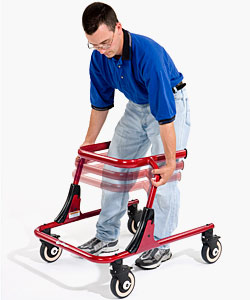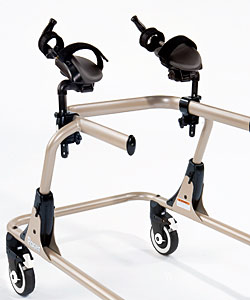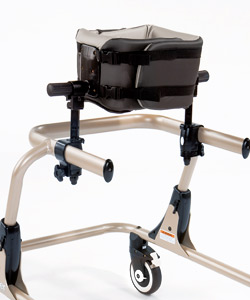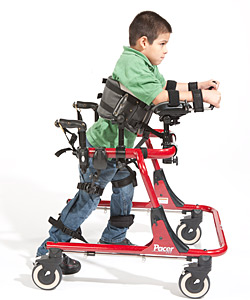In the Pacer gait trainer children with a wide variety of disabilities can gain independent movement while provided with appropriate support. The Pacer accessories (we call them prompts) are infinitely adjustable to accommodate the individual needs of almost any person. Each prompt is also removable so as the client’s motor skills improve they can be removed.
 Many people use the Pacer without fully appreciating the adjustments that are possible. In this post I will talk about the Pacer frame and upper body positioning. Next week I’ll look at lower body positioning and the Pacer casters.
Many people use the Pacer without fully appreciating the adjustments that are possible. In this post I will talk about the Pacer frame and upper body positioning. Next week I’ll look at lower body positioning and the Pacer casters.
The Rifton Pacer Frame
While the Pacer comes in five sizes, the three largest sizes can be folded for storage or transport.
 The Pacer’s telescoping uprights allow for smooth height adjustment so the Pacer can grow with your child. Generally we recommend positioning the top bar of the Pacer mobile frame at the user’s hip height.
The Pacer’s telescoping uprights allow for smooth height adjustment so the Pacer can grow with your child. Generally we recommend positioning the top bar of the Pacer mobile frame at the user’s hip height.
With the Pacer’s modular clamps, prompts can be positioned anywhere along the top bar of the frame but generally we recommend the locations detailed below.
 The Arm Prompts of the Pacer Gait Trainer
The Arm Prompts of the Pacer Gait Trainer
When using the Pacer in the anterior position we recommend placing the arm prompts just in front of the uprights along the top bar of the frame.
 The arm prompts, used in conjunction with other prompts, provide the support and positioning needed for each individual. Positioning of the arm is critical, and therapists should become familiar with all the adjustability of the arm prompts; they can be moved in any plane at any angle. This is very helpful for users with contractures.
The arm prompts, used in conjunction with other prompts, provide the support and positioning needed for each individual. Positioning of the arm is critical, and therapists should become familiar with all the adjustability of the arm prompts; they can be moved in any plane at any angle. This is very helpful for users with contractures.
For diagrams showing the range of adjustability, read our Arm Prompt Adjustability article. With the arm prompts horizontal, placed with elbows below  the shoulders, weight is shared through the shoulder girdle and arms, freeing the legs to move. Tilting the arm prompts down can encourage extended arm use prior to transitioning to walking with handholds. Arm prompts can also be placed along the front bar of the frame for a forward-leaning position.
the shoulders, weight is shared through the shoulder girdle and arms, freeing the legs to move. Tilting the arm prompts down can encourage extended arm use prior to transitioning to walking with handholds. Arm prompts can also be placed along the front bar of the frame for a forward-leaning position.
The Pacer Gait Trainer Chest Prompt
 Place the chest prompt clamps just behind the uprights of the frame when using the Pacer in the anterior position.
Place the chest prompt clamps just behind the uprights of the frame when using the Pacer in the anterior position.
Place the padded chest prompt around the user for maximum support leaving enough room under the armpits with no discomfort. (Height can be adjusted in 1” increments using the white button on the clamps.) For some users, the chest prompt is more effective when positioned lower, as a support around the abdomen. This prompt can either be secured snugly for a dependent user, or fastened more loosely for someone who demonstrates improved strength and stability. Allowing more movement within the chest prompt may enable weight-shifting and some rotation of the trunk during gait, while still providing balance-control assist, thus encouraging development of more trunk control.
Clamps can be placed on the inside or outside of the frame, depending on the size of the individual. Further width adjustment is possible if you loosen the chest prompt knobs and slide the supports laterally, retightening the knobs securely. Use the same knobs to adjust the chest prompt tilt in 15° increments for a forward-leaning position.
 People who have difficulty initiating forward movement may have more success when in a forward-leaning posture. This keeps hips back and places the center of gravity forward to promote better forward momentum. This can be helpful for someone who demonstrates spasticity or extensor tone. The key to providing the appropriate amount of forward lean is the placement and angle of the hip positioner, chest prompt, and arm prompts: to increase forward-lean move the hip positioner back and the arm prompts forward, and tip the chest prompt
People who have difficulty initiating forward movement may have more success when in a forward-leaning posture. This keeps hips back and places the center of gravity forward to promote better forward momentum. This can be helpful for someone who demonstrates spasticity or extensor tone. The key to providing the appropriate amount of forward lean is the placement and angle of the hip positioner, chest prompt, and arm prompts: to increase forward-lean move the hip positioner back and the arm prompts forward, and tip the chest prompt  forward.
forward.
It is important to note that pelvic positioning – so important for gait practice – can be closely controlled by where the hip positioner is placed on the Pacer frame.
With practice, many users will develop the skills they need to allow them to move to a more upright position. Positioning the arm prompts near the uprights with the chest prompt vertical encourages an upright standing position.
The Posterior Position in the Pacer Gait Trainer
 The posterior position is most often used for people who need only minimal gait support. Moving into the posterior position usually comes after what we call prompt reduction – the gradual decrease of supports from the Pacer gait trainer frame to further challenge the strengths of a user.
The posterior position is most often used for people who need only minimal gait support. Moving into the posterior position usually comes after what we call prompt reduction – the gradual decrease of supports from the Pacer gait trainer frame to further challenge the strengths of a user.
To use the Pacer in the posterior position, the arm prompts are placed with the opening of the frame in front. The cross bar of the upper frame behind the child can serve as a posterior guide to the pelvis when the height of the frame and arm prompts are adjusted appropriately.
The chest prompt can be lowered in place to serve as a hip corral.
Please note: This article does not replace the direct personal involvement and guidance of a medical professional.
Also see our post on lower body positioning in the Pacer gait trainer.
Back to Top